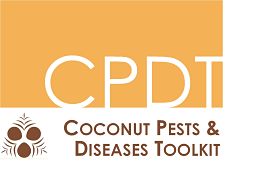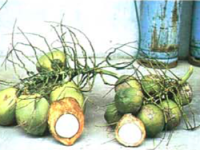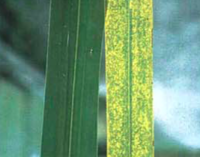Cadang-cadang disease
The coconut cadang cadang viroid (CCCVd) causes a lethal disease of coconut. The disease is found in the Phillippines. This is a HIGH risk disease of coconut in the Pacific.
Common name of the diseaseCadang-cadang disease |
Scientific name of the cause of the diseaseCoconut cadang-cadang viroid (CCCVd) |
on this page: Symptoms : Impacts : Distribution : Prevention : Controlling cadang-cadang : Information sources and further reading
Cadang-cadang disease is caused by a viroid. Viroids are similar to viruses, but are even smaller and more simple in their biology. While viruses are made up of DNA or the very similar molecule RNA**, enclosed in a protein coat, viroids are just much smaller lengths of naked RNA.
See the Symptoms below to help identify the infection.
Little is known of cadang-cadang disease. A few studies have investigated it’s distribution, development and possible control methods.
The frequency of disease tends to increase from fruit-bearing age or 10 years and up.
How the disease spreads is still unknown. Possible ways of transmission that have been found at low rates include mechanical damage, seed and pollen but other modes are suspected.
This viroid is unique in its ability to change its genetic form, which results in three distinct stages of infection. The first genetic form in the initial stage of infection is the smallest infectious viroid and pathogen known!
**RNA and DNA are molecules (chemical building blocks) known as nucleic acids, and both are used for transmitting genetic information within (and between) living things. Structurally, DNA and RNA molecules are almost identical. However, there are fundamental differences between the two that leads to the molecules having very different functions. A simplified perspective is that plants, animals, fungi and bacteria use only DNA as the template for their genetic make-up. These organisms use different types of RNA to transmit information, usually to make up amino acids, and then proteins. The genetic material of viruses can be DNA or RNA. RNA viruses (and viroids) use RNA as the template for their genetic make-up and for transmitting information.
Symptoms
Affected palms show a well defined series of symptoms before they eventually die. There are thee main stages of infection to look out for:
-
Nuts become rounded, have equatorial (around the middle) scarring and reduced husk thickness. Leaflets have yellow, non-necrotic (not decaying) leaf spots. This stage will last 2-4 years.
-
Lasting for a further 2 years, in this stage leaf spots will be more visible as they are larger and there are more of them. Inflorescences (all parts of the flower) also have spots while frond growth decreases and the production of nuts stops.
-
Crowns of affected palms in stage 3 will be a lot smaller than healthy palms. Most of the fronds will have the distinctive yellow spots or are reduced due to death. The palm may survive for about 5 years in this state before death.
|
Healthy nuts (L) vs. diseased rounded nuts with reduced husks (R) (© Dagmar Hanold and John Randles, Waite Agricultural Research Institute) |
Healthy leaf (L) vs. diseased leaf with distinctive yellowing (R) (© Dagmar Hanold and John Randles, Waite Agricultural Research Institute) |
Mature palms may be able to withstand the disease for longer in each stage.
Impacts
Although cadang-cadang disease has not spread greatly in the past 26 years, it is the most high risk viroid disease due to its lethal impacts on palms. It is estimated to have killed 300,000 palms per year since the first record in 1980. The spread to other regions could cause major impacts to coconut industries as the current control methods have failed, and the way it spreads is unknown. Therefore, millions of palms would likely die.
Infected palms result in loss of production (especially in copra) and palms have to be replanted. Replanting costs can be around US$100 per palm. Based on the current estimate of palm deaths from cadang-cadang disease (300,000 palms per year), this is a huge economic impact (approximately USD 30 million annually).
Socio-economic effects are also notable. The large scale reduction in plantations and therefore production, reduces employment opportunities, availability of coconut products, international trade and can drastically change the visual environment.
Distribution
Please check with your local biosecurity / quarantine or SPC for up-to-date distribution information.
Cadang-cadang disease is widely distributed in the central Philippines.
Prevention
Cadang-cadang disease is listed on the EPPO A1 list of quarantine pests and is a registered quarantine pest by many other Plant Protection organisations.
Factors that increase the risk of cadang-cadang disease becoming unmanageable include unrestricted movement of coconut seeds and tissues for breeding, production and seed trade. However, quarantine / biosecurity may not be sufficient as the progression of the disease is slow and it makes detection of infected palms difficult including misdiagnosis as other diseases.
The slow progress of the disease also makes surveillance difficult.
A considerable risk is the current lack of knowledge on how the disease is transmitted, the original site of infection and what spreads it. Viroids are also known to have a high rate of mutation creating the risk of new strains.
The Philippines have put quarantine protocols in place and due to cadang-cadang disease's high economic impact. They have banned the movement of live tissues (seeds, nuts and pollen) locally and internationally to prevent its spread.
For general information on preventing pests and diseases of coconut, see the Prevention section.
Controlling cadang-cadang disease
There are no known natural or chemical controls. However, removing diseased palms and replanting at the first sign of disease can reduce loss of crops.
Exclusion and stopping the transport of plant material from diseased areas is the only method considered to be effective in controlling the spread of cadang-cadang disease. It is recommended to apply caution when dealing with cadang-cadang disease and follow guidelines for other related viroids.
Testing for viroids is possible, but not easy. Only a few very specialised laboratories are capable of this work. Please contact SPC for further information.
Information sources and further reading
CABI. 2008. Coconut cadang-cadang viroid (cadang-cadang disease). [ONLINE]
CABI and EPPO. 2017. Data Sheets on Quarantine Pests; Coconut cadang-cadang viroid. EPPO quarantine pests. pp. 1-4.
Hanold, Randies. 1991. Coconut cadang-cadang disease and its viroid agent. Plant Disease, 75(4), pp.330-335.
Jeger, Bragard, Caffier, Candresse, Dehnen‐Schmutz, Gilioli, Gregoire, Miret, Anton, MacLeod, Navajas Navarro. 2017. Pest categorisation of Cadang‐cadang viroid. EFSA Journal, 15(7).
Plant Village. 2018. Coconut; Diseases and Pests, Description, Uses, Propagation. [ONLINE]
Plantwise. 2018. Cadang cadang disease (Coconut cadang-cadang viroid). [ONLINE]
Rodriguez, Randles. 2018. Descriptions of Plant Viruses: Coconut cadang-cadang viroid. [ONLINE]
content reviewed by Richard Davis, Northern Australia Quarantine Strategy, Department of Agriculture and Water Resources, July 2018


